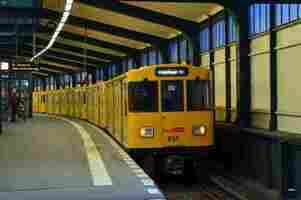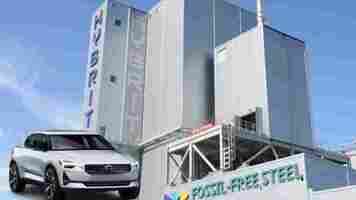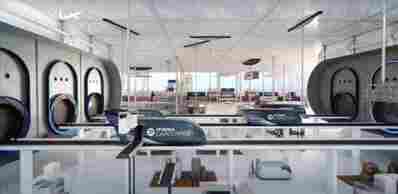Germany sticks it to Russia by offering a €9 monthly public transport ticket
In an effort to reduce its reliance on Russian oil, the German government is slashing the cost of public transport for residents.

In summer 2022, people living in Germany can get a monthly public transport ticket for only €9 euros per month — a tenth of its usual price. The ticket will be offered for three months and will be called “9 for 90”.


The move is in response to rising energy and fuel prices caused by the Ukraine war . The German government wants to halve its Russian oil imports by June.
According to Al Jazeera , before the war began on February 24, a third of Germany’s oil imports, 45% of its coal purchases, and 55% of gas imports came from Russia.
Economy Minister Robert Habeck wants to be “almost independent” of Russian oil by the end of 2022.
Will cheap tickets mean greater public transport use?
It’s unclear how much impact the subsidized public transport will have on car ownership or usage.
It’s likely to lead to more people purchasing the low-cost tickets. But this doesn’t necessarily translate to more people abandoning their cars for a trip by train, tram, or bus.
Or that people will continue using public transport once the summer ends — no one likes waiting in the cold for a bus.
Further, while the city of Berlin and other major cities like Hamburg and Frankfurt are well serviced by public transport, this is unsurprisingly not the case in rural Germany, where 90% of households own at least one car.
Low population density in rural areas limits the access and frequency of public transport. It also limits the development of bike paths and any last-mile solutions.
A survey earlier this year found that 75% of German households who regularly use their car are willing to switch to public transport. 66% could imagine taking their bike more often. The survey further revealed that rural folks are almost equally as willing to take a bicycle as city dwellers.
However, it also found that 40% of German households who see their car as a status symbol are not willing to switch to a bike under any circumstances. So the challenges are not only logistical, but cultural.
But, is there an opportunity for a third way?
Not quite a bus and not quite a taxi
Since September 2018, Berlin has trialed an on-demand carpooling electric shuttle service called Berlkönig , which has a fleet of over 300 vehicles.
The BVG app is used to book each journey. An algorithm bundles travel requests from several passengers with the same destination. This creates a route, and books the passengers into a shared vehicle.
It’s cheaper than a taxi and more convenient than a bus, with over two million trips so far.
Could rural areas expand on this kind of initiative? I think it could be especially effective in regional areas with an aging population.
Thus, it could create a more lasting way to get people out of their cars, if not provide a bridge between home and public transport . And ultimately, reduce German reliance on Russian fossil fuels.
edit: The article was updated to reflect that the ticketing discount is being deployed throughout Germany.
Volvo bets on fossil fuel-free steel for the future of car making
Volvo has joined forces with Swedish steel manufacturer SSAB to explore the development of fossil fuel-free steel for its cars.

This makes Volvo the first automaker to embark on the search of a green alternative for steel production, which is otherwise responsible for about 7% of global direct carbon emissions.
Specifically, steelmaking has a big carbon footprint, generating last year over 3 billion tons of CO2 . That’s because t he furnaces that melt iron ore to make steel consume vast amounts of coal, which is a major energy source, but a fossil fuel nonetheless.
For this reason, Volvo will collaborate with SSAB’s experimental HYBRIT plant in Sweden, which claims to be the first in the world to use hydrogen instead of coal as the furnace’s fuel source. That’s a promising project, given that hydrogen will be produced by zero-carbon electricity from wind farms and hydro dams.
Volvo will purchase carbon-free steel made at the HYBRIT factory, and is even planning on manufacturing the first concept vehicles and machines with steel made by SSAB already in 2021.
“As we continuously reduce our total carbon footprint, we know that steel is a major area for further progress,” explained Håkan Samuelsson, chief executive at Volvo Cars. “The collaboration with SSAB on fossil-free steel development could give significant emission reductions in our supply chain.”
Nevertheless, the project’s still in its infancy. SSAB aims to start commercial sales in 2026, and Volvo will limit itself to a s maller-scale serial production during 2021, before attempting mass production later on.
Let’s hope that Volvo’s involvement will build momentum around this dawning green hydrogen tech, enough to push the industry to consider more climate-friendly steelmaking alternatives.
Do EVs excite your electrons? Do ebikes get your wheels spinning? Do self-driving cars get you all charged up?
Then you need the weekly SHIFT newsletter in your life. Click here to sign up
Virgin Hyperloop abandons dream of being first to shoot people through tubes
If you’re looking for technology with a fast time to market, you can exclude most vehicles and mobility tech. And if you’re waiting for a ride in a hyperloop ? Don’t hold your breath.

I’ve been writing about hyperloop tech for nearly ten years. Much of the innovation is happening behind the scenes. It’s partnerships and pathways , rules and regulations, and in the case of tech — it’s most often R&D in stealth mode.
Every so often, a company will send over illustrations or videos made in CGI of what the hyperloop will look like in practice, but there’s not usually all that much to go on.
So, when news hit last month that Virgin Hyperloop was abandoning its effort to be the first people carrier, as well as laying off over 100 staff, I can’t say I was that surprised, having previously ranked the company more for its hype and PR than its actual substance.
From hype to hyperloop fail
In November 2020, Virgin Hyperloop successfully launched a two-seat prototype ridden by two staff members. The hyperloop traveled 500 meters, reaching 172 kilometers per hour within 6.25 seconds.
The company claimed to have carried out over 500 tests in Las Vegas and released a new explainer video on Twitter .
But then, last month, we saw that the dream had pivoted from people to cargo, with the decision attributed to the supply chain and logistical challenges caused by COVID-19 over the last couple of years.
Perhaps the most significant push was the departure of CEO and co-founder Josh Giegel after seven years at the company in October last year.
The Senior Vice President of Engineering, Steven Hobart , left just a few months earlier after a 6-month stint.
Short stays are not uncommon in the world of autonomous vehicles, eVTOLs, and hyperloops, but retrenching over 100 staff just months later shows a fundamental flaw in the financing and execution of hyperloop’s people-carrying dream.


Fortunately, Virgin had presciently founded another hyperloop company under its umbrella: DP World Cargospeed systems . This had a mission to deliver time-critical goods like medical supplies and vaccines.
Much like with drones and eVTOLs , cargo deliveries are far more manageable than people-carrying when it comes to laws and regulations, and it’s no surprise that DP World can accelerate the launch of a commercial hyperloop.
What does the end of Hyperloop One mean for rural hyperloops?
But the question is what the end of the Virgin Hyperloop One (at least in its current form) means for global development and infrastructure plans.
Hyperloop had committed to routes in Dubai, India (between Mumbai and Pune), and in the US, North Carolina, and Texas.
Unfortunately, there’s no evidence that the company was already boring tunnels or creating above-ground infrastructure, beyond test track approval on the Mumbai Pune route.
I wish there had been, as it could have paved the way for their competitors in these regions where public transport is often cast aside by prioritizing road infrastructure.
Digging holes or establishing foundations would have helped attract other hyperloop competitors to the area. Will DP take over the planned Virgin Hyperloop One routes for freight delivery? It’s unclear, as its interest has been firmly in the Middle East.
Could there have been another way?
I’m thinking of the work of Polish hyperloop company Nevomo , who rather sensibly focused on developing MagRail transportation tech which upgrades existing railway infrastructure at speed with the capacity to transform it into a vacuum hyperloop later. It’s an extremely clever business model when considering that each iteration has something tangible to offer.
But the cutbacks at Virgin One leave us with more questions than answers. Just another delay to getting people into hyperloops.
All transport companies have been hit hard over the last couple of years. The question will be whether DP or another provider will agree to reinvigorate the hyperloop in India. Or will it be just another (excuse the pun) pipe dream in innovation?